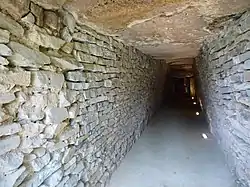Tholos de El Romeral
Tholos de El Romeral, situated 2.5 kilometres (1.6 mi) north east of the town of Antequera (Andalusia), is one of the most important examples of early Bronze Age architecture in southern Europe. Tholos de El Romeral, also known as Cueva de Romeral (Cave of Romeral) and Dolmen de Romeral, is a megalithic burial site built circa 1800 BCE. It is one of three tombs in region, the others being Dolmen de Menga and Dolmen de Viera, both situated to the south west.
| Tholos de El Romeral | |
|---|---|
 Tholos de El Romeral; walls of small rubble, megalithic capstones | |
| Coordinates | 37°02′04″N 4°32′08″W |
| Official name | Antequera Dolmens Site |
| Type | Cultural |
| Criteria | i, iii, iv |
| Designated | 2016 (40th session) |
| Reference no. | 1501-002 |
| Region | Europe and North America |
In 2016, the dolmens of Menga, Viera, and El Romeral were all inscribed as a UNESCO World Heritage Site under the name "Antequera Dolmens Site".
Date
As late as the 20th century it was believed that the three megalithic tombs in the area (Dolmen de Menga, Dolmen de Viera and Tholos de El Romeral) originated from the same period. However subsequent research supports widely spaced dates between the first two (around 3800 BCE) and the construction of Tholos de El Romeral which is now thought to have been built around 1800 BCE. It is recognised and attributed to the wider culture of the Los Millares, which had its centre more than 200 kilometres to the east. The main reasons for this are the different stone materials used and the differing floor plans of the chambers, as the other two tombs have rectangular chambers.
Architecture
Tholos de El Romeral is a chambered tomb covered by a mound. It consists of a long corridor with drystone walls made of small stones and a ceilings made of megalithic slabs. The corridor culminates with two consecutive round beehive-like chambers. The larger chamber has a diameter of approximately 4.20 metres (13.8 ft) and has corbelled walls built in the same way as the corridor, projecting inwards and culminating in a megalithic capstone. The floor of the corridor and main chamber are made of packed earth. The second chamber is linked to the first by a rectangular corridor (and is not accessible to the public). It has a diameter of approximately 2 metres (6 ft 7 in), contains a stone slab bier, and the floor of the small room is covered with stone slabs. Bones and grave goods were found within the dolmen.
Although it is believed that these megalithic buildings had different uses (tombs, temples, etc.) the Romeral Dolmen is certainly a burial site because human remains, shells, and two types of ceramics were found within it.
Gallery
 Exterior view
Exterior view Exterior view
Exterior view Entrance passage
Entrance passage Interior chamber
Interior chamber Roof of the tholos
Roof of the tholos Entrance passage
Entrance passage Plan
Plan
See also
External links
- The Modern Antiquarian
- The Megalithic Portal
- Historia de la Arquitectura en España (page in Spanish)
